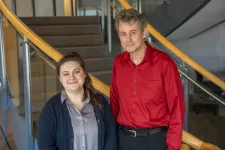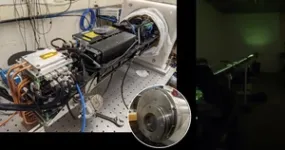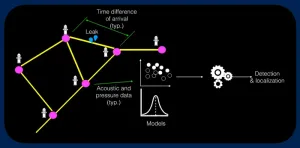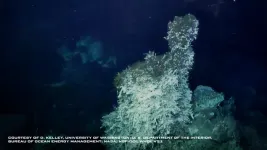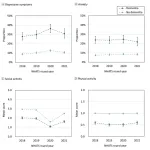(Press-News.org) Scientists at UMass Chan Medical School and the Marine Biological Laboratory at Woods Hole have identified the first gene—Bmal1—to play a crucial role in regulating circatidal behavior in the crustacean Parhyale hawaiensis. Circatidal rhythms help animals cope with the rise and fall of the tides in coastal areas.
Published in Current Biology, the study by neurobiologists Patrick Emery, PhD, Joshua Rosenthal, PhD, and colleagues demonstrates the first molecular link between circatidal and circadian clocks, while establishing P. hawaiensis as a powerful new animal system for studying the genetics underlying circatidal rhythms.
“Biological clocks are critical for organisms—including humans—to optimize their physiology and adapt their behavior to environmental cycles,” said Dr. Emery, vice chair and professor of neurobiology at UMass Chan Medical School and a Marine Biological Laboratory Whitman Center investigator. “By understanding how these behaviors are genetically hardwired into organisms, we can map the sensory systems and neural circuits that impact physiology and behavior.”
Tides occur every 12.4 hours. One of the two daily tides is caused by the gravitational pull of the moon on the Earth, while the second results from the centrifugal force created by the moon and Earth’s rotational movements in space. Marine animals that live in tidal areas have adapted behaviors to contend with these dramatic shifts from dry to aquatic environments every 12.4 hours.
Though circatidal rhythms were first observed in the early 20th century in the Roscoff worm (Symsagittifera roscoffensis) and studied in detail in crabs, mussels and other marine species since the 1950s, the molecular and genetic underpinnings of the circatidal clock, as well as its relationship to the circadian clock, has remained elusive.
“The lack of an animal model amendable to genetic knockdown and transgenic manipulations has prevented scientists from definitively investigating the molecular origins of the circatidal clock and its relation to circadian clock genes,” said Emery. “Only a handful of studies about circatidal genetics exist and these are unable to either rule in or rule out a role for circadian clock genes in circatidal behaviors in animals.”
Erica Kwiatkowski, an MD/PhD student in the Emery lab at UMass Chan, in collaboration with the lab of Dr. Rosenthal, senior scientist at the Marine Biological Laboratory, identified the small amphipod crustacean P. hawaiensis as a promising model. To simulate P. hawaiensis’ natural environment, the researchers developed an artificial tidal habitat in the lab for the one-centimeter-long animal using artificial seawater that was pumped in and out of an aquarium every 12.4 hours.
Kwiatkowski and colleagues exposed the amphipods to 10 cycles (the equivalent of five days) in the artificial tidal environment. Once acclimated to these conditions, P. hawaiensis was removed by the researchers from the artificial tidal environment and placed into a habitat with a constant water level. While in individual test tubes, the animals’ swimming activity was recorded using infrared beams. Strikingly, every 12.4 hours, the majority of the animals (80 percent) increased their swimming activity in anticipation of high tides and then reduced activity in anticipation of low tide, even though they no longer were exposed to changing water levels. This demonstrated the existence of a circatidal clock controlling locomotor behavior in P. hawaiensis.
The lab of Marine Biological Laboratory director, Nipam Patel, PhD, has developed P. hawaiensis as a model organism for studying genes controlling numerous aspects of embryo development, including limb patterning. “Over the years, the Patel lab created valuable resources in this organism, such as a sequenced genome and methods to knock-out genes using CRISPR. Although the original intention wasn't to use Parhyale for the study of circatidal rhythms, it has turned out to be excellent for this purpose. We predict that this organism will catalyze a lot of future research in this area,” Rosenthal said.
Once the strong presence of a circatidal rhythm in P. hawaiensis was established, Kwiatkowski and colleagues used CRISPR/Cas9-guided gene knockdown to hunt for genes connected to the circatidal behavior. By knocking down individual genes, scientists can observe the effect that a lost gene has on a biological process.
Using the genes that control circadian rhythms in mammals as a guide to looking for circatidal genes, Kwiatkowski and colleagues found that knocking down the circadian gene Bmal1 changed P. hawaiensis behavior—the animal no longer exhibited circatidal swimming behaviors. Instead, the animals exhibited arhythmic behavior unconnected to tidal flows.
“Bmal1 is a critical component for the maintenance of circatidal behavior in P. hawaiensis,” said Kwiatkowski. “This is the first evidence that a gene involved in circadian rhythms is also involved in circatidal rhythms. This establishes a molecular link between the two systems.”
The next step for Emery and colleagues is to investigate the exact role Bmal1 plays in driving circatidal behavior and which other genes may be involved.
END
Gene linking circadian and circatidal rhythms is discovered in tiny crustacean
2023-05-11
ELSE PRESS RELEASES FROM THIS DATE:
Fire hydrant hydrophones find water leaks #ASA184
2023-05-11
CHICAGO, May 11, 2023 – Access to clean drinking water is essential for healthy communities, but delivering that water is growing increasingly difficult for many utilities. Corroding pipes and land shifts in aging water distribution networks can create frequent leaks, wasting water before it ever gets to the tap. Utilities in the U.S. lose about 6 billion gallons of water a day — enough to fill 9,000 swimming pools — due to leaks, in addition to wasted energy and resources spent in collecting and treating that water.
Pranav Agrawal and Sriram Narasimhan from the University ...
InVADER mission to test its robotic laser divebot on a deep-sea expedition
2023-05-11
InVADER Mission to Test its Robotic Laser Divebot on a Deep-Sea Expedition
Team to test technologies for use in future planetary exploration while providing data to survey deep-sea ecosystems and minerals on Earth
May 11, 2023, Mountain View, CA – A team of scientists and engineers from the SETI Institute, Impossible Sensing, NASA JPL, and other institutions will test their innovative robotic laser system on a deep-sea expedition aboard the E/V Nautilus. The mission, called InVADER (In-situ Vent Analysis Divebot for Exobiology Research), aims to advance technologies to explore, ...
Rensselaer researcher uses artificial intelligence to discover new materials for advanced computing
2023-05-11
A team of researchers led by Rensselaer Polytechnic Institute’s Trevor David Rhone, assistant professor in the Department of Physics, Applied Physics, and Astronomy, has identified novel van der Waals (vdW) magnets using cutting-edge tools in artificial intelligence (AI). In particular, the team identified transition metal halide vdW materials with large magnetic moments that are predicted to be chemically stable using semi-supervised learning. These two-dimensional (2D) vdW magnets have potential applications in data storage, spintronics, and even quantum computing.
Rhone ...
Having dementia and reduction in social participation are associated with increased depression and anxiety during the COVID-19 pandemic
2023-05-11
Tokyo, May 8, 2023 -- An increased risk of depression and anxiety among US older adults with dementia and poor activity participation has been demonstrated through an analysis of data from the National Health and Aging Trends Study (NHATS), a nationally representative population-based study.
These findings were reached by a team of researchers from the Tohoku University Graduate School of Medicine, Exploratory Oncology Research and Clinical Trial Center in National Cancer Center, and Tokyo Metropolitan Institute of Medical Science, Japan. This study is published in the Journal of Alzheimer’s Disease Reports 7(1).
The coronavirus disease 2019 (COVID-19) ...
Targeting uncontrolled inflammation may hold the key to treating therapy-resistant cancers
2023-05-11
GRAND RAPIDS, Mich. (May 11, 2023) — Van Andel Institute scientists have pinpointed how a specific gene mutation triggers an inflammatory cascade that may drive development of treatment-resistant cancers.
The new findings, published today in Molecular Cell, reveal for the first time the molecular circuitry by which mutations in the gene STK11 cause inflammation to spiral out of control. The resulting chemical firestorm damages healthy cells and can enable cancer development. Tumors that lose the STK11 gene are tough ...
With new experimental method, researchers probe spin structure in 2D materials for first time
2023-05-11
PROVIDENCE, R.I. [Brown University] — For two decades, physicists have tried to directly manipulate the spin of electrons in 2D materials like graphene. Doing so could spark key advances in the burgeoning world of 2D electronics, a field where super-fast, small and flexible electronic devices carry out computations based on quantum mechanics.
Standing in the way is that the typical way in which scientists measure the spin of electrons — an essential behavior that gives everything in the physical universe its structure — usually doesn’t work in 2D materials. This makes it incredibly difficult to fully understand the materials and propel forward technological ...
These sounds are out of this world! #ASA184
2023-05-11
CHICAGO, May 11, 2023 – You may know how other planets look, like the rust orange, dusty surface of Mars or the vibrant teal of Uranus. But what do those planets sound like?
Timothy G. Leighton from the University of Southampton in the U.K. designed a software program that produces extraterrestrial environmental sounds and predicts how human voices might change in distant worlds. He will demonstrate his work at the upcoming 184th Meeting of the Acoustical Society of America, running May 8-12 at the Chicago Marriott Downtown Magnificent Mile Hotel. His presentation will take place ...
New composite strategy leaves coverage questions behind, researchers report
2023-05-11
Answers could be cloudy for researchers using Landsat images to investigate the coverage of the continental United States. The National Land Cover Database (NLCD) are useful products for scientists to understand how things like tree canopy and road coverage changes over time, but something as simple as cloud coverage can be misinterpreted in the satellite images as a significant surface coverage change. How can researchers be sure they’re getting a truly representative understanding of any one area?
The answer lies in composite ...
Comparison of depression and anxiety following self-reported COVID-19–like symptoms vs SARS-CoV-2 seropositivity
2023-05-11
About The Study: In this study of more than 45,000 individuals drawn from the French general population, COVID-19–like symptoms, but not SARS-CoV-2 infection, during the first months of the pandemic were associated with an increased occurrence of subsequent depression and anxiety eight months or more after the occurrence of COVID-19–like symptoms, even when SARS-CoV-2 serologic test results were negative.
Authors: Alexandra Rouquette, M.D., Ph.D., of the Université de Versailles Saint-Quentin-en-Yvelines in Paris, is the corresponding ...
Trends in the prevalence of functional limitations among cancer survivors
2023-05-11
About The Study: The number of U.S. cancer survivors with self-reported functional limitation has more than doubled during the past 20 years, with relatively less growth in the number of limitation-free survivors.
Authors: Vishal R. Patel, B.S., of the University of Texas at Austin, is the corresponding author.
To access the embargoed study: Visit our For The Media website at this link https://media.jamanetwork.com/
(doi:10.1001/jamaoncol.2023.1180)
Editor’s Note: Please see the article for additional information, including other authors, ...
